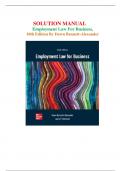SOLUTION MANUAL
Employment Law For Business,
10th Edition By Dawn Bennett-Alexander
,Table Of Content
PART ONE: THE REGULATION OF THE EMPLOYMENT RELATIONSHIP
1 The Regulation Of Employment
2 The Employment Law Toolkit: Resources For Understanding The Law And Recurring Legal Concepts
3 Title VII Of The Civil Rights Act Of 1964
4 Legal Construction Of The Employment Environment
PART TWO: REGULATION OF DISCRIMINATION IN EMPLOYMENT
5 Affirmative Action
6 Race And Color Discrimination
7 National Origin Discrimination
8 Gender Discrimination
9 Sexual Harassment
10 Sexual Orientation And Gender Identity Discrimination
11 Religious Discrimination
12 Age Discrimination
13 Disability Discrimination
PART THREE: REGULATION OF THE EMPLOYMENT ENVIRONMENT
14 The Employee’s Right To Privacy And Management Of Personal Information
15 Labor Law
16 Selected Employment Benefits And Protections
,INSTRUCTOR MANUAL FOR
Employment Law For Business, 10th Edition, Dawn Bennett-
AlexanderChapter 1-16
Chapter 1
The Regulation Of Employment
Chapter Objective
The Student Is Introduced To The Regulatory Environment Of The Employment Relationship.
The Chapter Examines Whether Regulation Is Actually Necessary Or Beneficial Or If, Perhaps,
The Relationship Would Fare Better With Less Governmental Intervention. The Concepts Of
―Freedom‖ To Contract In The Regulatory Employment Environment And Non-Compete
Agreements Are Discussed. Since The Regulations And Case Law Discussed In This Text Rely
On An Individual‘S Classification As An Employer Or An Employee, Those Definitions Are
Delineated And Explored.
Learning Objectives
(Click On The Icon Following The Learning Objective To Be Linked To The Location In
The OutlineWhere The Chapter Addresses That Particular Objective.)
At The Conclusion Of This Chapter, The Students Should Be Able To:
1. Describe The Balance Between The Freedom To Contract And The Current
RegulatoryEnvironment For Employment.
2. Identify Who Is Subject To Which Employment Laws And Understand The Implication
Of EachOf These Laws For Both The Employer And Employee.
3. Delineate The Risks To The Employer Caused By Employee Misclassification.
4. Explain The Difference Between And Employee And An Independent Contractor And
The TestsThat Help Us In That Determination.
5. Articulate The Various Ways In Which The Concept ―Employer‖ Is Defined By The
Various Employment-Related Regulations.
6. Describe The Permissible Parameters Of Non-Compete Agreements.
Detailed Chapter Outline
Scenarios—Points For Discussion
, Scenario One: This Scenario Offers An Opportunity To Review The Distinctions Between
An Employee And An Independent Contractor Discussed In The Chapter (See ―The
Definition Of Employee,‖ Particularly Exhibits 1.3–1.5). Discuss The IRS 20-Factor
Analysis, As It Applies ToDalia‘S Position. In Light Of The Low Level Of Control That
Dalia Had Over Her Fees And Her WorkProcess, And The Limits Upon Her Choice Of
Clients, Students Should Come To The Conclusion ThatDalia Is An Employee (Therefore,
Eligible To File An Unemployment Claim), Rather Than An Independent Contractor.
Scenario Two: Soraya Would Not Have A Cause Of Action That Would Be Recognized By
The EEOC.Review The Section ―The Definition Of ‗Employer‘‖ With Students, And Discuss
The Rationale That Determines The Status Of A Supervisor Vis-À-Vis Anti-Discrimination
Legislation. Because Soraya Is Soraya‘S Supervisor, Not Her Employer, He Cannot Be The
Target Of An EEOC Claim Of Sexual Harassment.
CCC, Soraya‘S Employer, Would Be Vulnerable To An EEOC Claim If The Company Lacked
Or FailedTo Follow A System For Employee Redress Of Discrimination Grievances. However,
In This Case, CCC Appears To Have A Viable Anti-Discrimination Policy That It Adhered To
Diligently; Consequently, Soraya Would Be Unlikely To Win A Decision In Her Favor. The
Court In Williams V. Banning (1995) Offered The Following Rationale For Its Decision In A
Similar Case:
―She Has An Employer Who Was Sensitive And Responsive To Her Complaint. She Can
Take Comfort In The Knowledge That She Continues To Work For This Company,
While Her HarasserDoes Not And That The Company's Prompt Action Is Likely To
Discourage Other Would Be Harassers. This Is Precisely The Result Title VII Was Meant
To Achieve.‖
Scenario Three: Students Should Discuss Whether Or Not Mya Non-Compete Agreement Is
Likely ToBe Found Reasonable By A Court, And Elaborate The Aspects Of The Agreement
That Mya Might Contest As Unreasonable (See Section Below, ―Covenants Not To Compete‖).
Does Mya Have A Persuasive Argument That The Terms Of Her Non-Compete Agreement Are
Unreasonable In Scope Or Duration? Might She Have Grounds To Claim That The Agreement
Prohibits Her From Making A Living?
Given The Diversity Of State Laws Regulating Non-Compete Agreements, Discuss The Range
Of LegalRestrictions That Might Apply To Mya‘S Particular Agreement With Her Employer.
As An EmployeeWho Works Across Several States, Mya‘S Defense May Depend Upon The
Presence—And Specific Language—Of A Forum Selection Clause In Her Non-Compete
Agreement. Consider What Language Would Be More Likely To Provide Nan With A Strong
Defense Against The Breach Of Contract Claim.
Mya Might Also Argue That The Company‘S Client List Is Available Through Public
Means, AndTherefore, Her Access To This List Should Not Be Prohibited.
General Lecture Note For Employment Law Course




